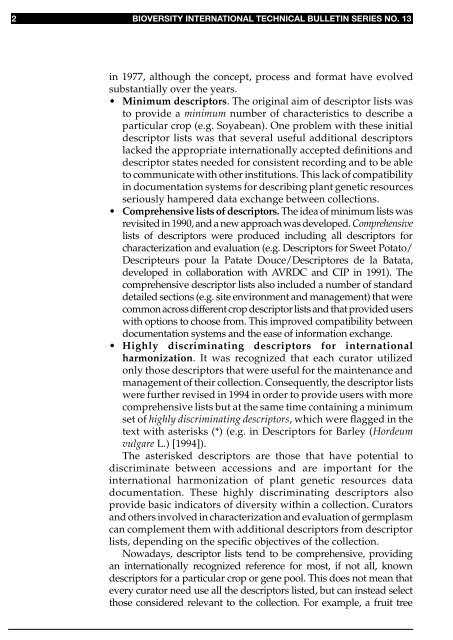Developing crop descriptor lists - Bioversity International
Developing crop descriptor lists - Bioversity International
Developing crop descriptor lists - Bioversity International
Create successful ePaper yourself
Turn your PDF publications into a flip-book with our unique Google optimized e-Paper software.
2 BIOVERSITY INTERNATIONAL TECHNICAL BULLETIN SERIES NO. 13<br />
in 1977, although the concept, process and format have evolved<br />
substantially over the years.<br />
• Minimum <strong>descriptor</strong>s. The original aim of <strong>descriptor</strong> <strong>lists</strong> was<br />
to provide a minimum number of characteristics to describe a<br />
particular <strong>crop</strong> (e.g. Soyabean). One problem with these initial<br />
<strong>descriptor</strong> <strong>lists</strong> was that several useful additional <strong>descriptor</strong>s<br />
lacked the appropriate internationally accepted definitions and<br />
<strong>descriptor</strong> states needed for consistent recording and to be able<br />
to communicate with other institutions. This lack of compatibility<br />
in documentation systems for describing plant genetic resources<br />
seriously hampered data exchange between collections.<br />
• Comprehensive <strong>lists</strong> of <strong>descriptor</strong>s. The idea of minimum <strong>lists</strong> was<br />
revisited in 1990, and a new approach was developed. Comprehensive<br />
<strong>lists</strong> of <strong>descriptor</strong>s were produced including all <strong>descriptor</strong>s for<br />
characterization and evaluation (e.g. Descriptors for Sweet Potato/<br />
Descripteurs pour la Patate Douce/Descriptores de la Batata,<br />
developed in collaboration with AVRDC and CIP in 1991). The<br />
comprehensive <strong>descriptor</strong> <strong>lists</strong> also included a number of standard<br />
detailed sections (e.g. site environment and management) that were<br />
common across different <strong>crop</strong> <strong>descriptor</strong> <strong>lists</strong> and that provided users<br />
with options to choose from. This improved compatibility between<br />
documentation systems and the ease of information exchange.<br />
• Highly discriminating <strong>descriptor</strong>s for international<br />
harmonization. It was recognized that each curator utilized<br />
only those <strong>descriptor</strong>s that were useful for the maintenance and<br />
management of their collection. Consequently, the <strong>descriptor</strong> <strong>lists</strong><br />
were further revised in 1994 in order to provide users with more<br />
comprehensive <strong>lists</strong> but at the same time containing a minimum<br />
set of highly discriminating <strong>descriptor</strong>s, which were flagged in the<br />
text with asterisks (*) (e.g. in Descriptors for Barley (Hordeum<br />
vulgare L.) [1994]).<br />
The asterisked <strong>descriptor</strong>s are those that have potential to<br />
discriminate between accessions and are important for the<br />
international harmonization of plant genetic resources data<br />
documentation. These highly discriminating <strong>descriptor</strong>s also<br />
provide basic indicators of diversity within a collection. Curators<br />
and others involved in characterization and evaluation of germplasm<br />
can complement them with additional <strong>descriptor</strong>s from <strong>descriptor</strong><br />
<strong>lists</strong>, depending on the specific objectives of the collection.<br />
Nowadays, <strong>descriptor</strong> <strong>lists</strong> tend to be comprehensive, providing<br />
an internationally recognized reference for most, if not all, known<br />
<strong>descriptor</strong>s for a particular <strong>crop</strong> or gene pool. This does not mean that<br />
every curator need use all the <strong>descriptor</strong>s listed, but can instead select<br />
those considered relevant to the collection. For example, a fruit tree

















